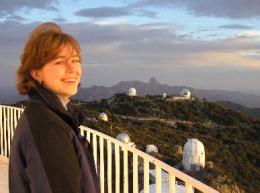This is the unofficial website of the NSF AAPF program, run by the fellows themselves. For official information about the fellowship, please go to the NSF program announcement.
Rachel Kuzio de Naray

The framework of large scale structure formation relies heavily on the idea of cold dark matter. The predictions of CDM on large scales seem to be consistent with observations, but it is not readily apparent that the theory's success extends to small (galaxy) scales. The rotation curve shapes and dark matter halo central densities of low surface brightness galaxies are typically more consistent with cored dark matter halos than the cuspy CDM halos predicted by numerical simulations. Reconciling the predictions of numerical simulations with observations of dark matter-dominated galaxies is currently one of the greatest challenges for CDM.
My research involves improving the observational data and collaborating with theorists/simulators to increase our understanding of CDM on small scales. I have observed a sample of well-resolved H-alpha velocity fields of LSB galaxies that not only address a variety of possible systematic effects in previous data, but will also provide important constraints on galaxy-halo simulations. I am also interested in exploring well-motivated alternative dark matter candidates that produce cored halos in galaxy sized dark matter halos.
I am a member of the Carnegie-Irvine Nearby Galaxies Survey (CINGS) collaboration. CINGS has optical broadband imaging of 603 of the brightest nearby galaxies in the Southern hemisphere and has plans for follow-up spectroscopy using the new GISMO instrument on Magellan. The CINGS sample will allow us to test whether or not LSB galaxies preferentially reside in low concentration halos.
I will develop a new observation-based group project for the Astronomy & Astrophysics cluster of the California State Summer School for Math and Science (COSMOS), a month-long residential summer program for high school juniors and seniors. Using galaxy rotation curve data that I have obtained at Kitt Peak National Observatory, the students will explore the observational evidence of the existence of dark matter.